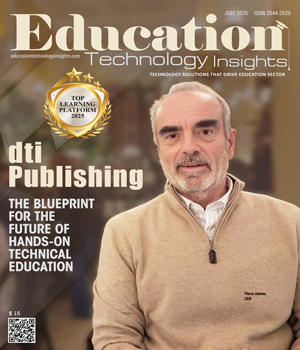THANK YOU FOR SUBSCRIBING
Be first to read the latest tech news, Industry Leader's Insights, and CIO interviews of medium and large enterprises exclusively from Education Technology Insights
Exploring New Technological Frontiers in STEM Education
Sean Beaverson, Director of Technology at Orono Public Schools and Andrew Rummel, Digital Learning Coordinator for Bloomington Public Schools
Sean Beaverson is the Director of Technology at Orono Public Schools, with over 25 years of experience in educational technology. He specializes in implementing innovative solutions that enhance teaching, learning, and operational efficiency. With expertise in strategic planning and fostering collaboration, Sean is creating inclusive, engaging learning environments that prepare students for the future. Sean Beaverson, Director of Technology at Orono Public Schools and Andrew Rummel, Digital Learning Coordinator for Bloomington Public Schools
Sean Beaverson, Director of Technology at Orono Public Schools and Andrew Rummel, Digital Learning Coordinator for Bloomington Public Schools
Through this profile, Beaverson highlights the potential of artificial intelligence to strengthen STEM education by supporting diverse learning approaches, beyond traditional assessment, fostering cross-disciplinary connections, and strengthening career pathways.
STEM education continues to evolve as a cornerstone in preparing students for the future, equipping them with essential skills like problem-solving, creativity, and resilience. As emerging technologies reshape our world; thoughtful integration of artificial intelligence presents intriguing possibilities for supporting teaching and learning. While the impact of these tools on education is still unfolding, careful exploration of their potential could strengthen STEM education in ways that are both meaningful and sustainable.
Modern digital tools show promise in broadening how students engage with STEM content. By enhancing—rather than replacing—the social, collaborative aspects of learning, technology could help cultivate curiosity and a sense of wonder in the classroom. Educators, as facilitators of exploration, can use AI tools to support diverse learning approaches while maintaining the balance between independent discovery and teamwork that makes STEM education so engaging.
Digital tools could also help streamline repetitive tasks, allowing teachers to dedicate more time to meaningful, face-to-face interactions. As educators, we have an opportunity to ensure that technology serves as an enabler of relationships, keeping the focus on human connections that enrich learning.
Beyond Traditional Assessment
In today’s complex world, STEM education embraces real-world problem-solving and creativity, areas where traditional assessments may not capture the full picture. With AI-driven insights, teachers could gain a broader understanding of each student's problem-solving approach, providing opportunities to support growth in ways that feel personal and impactful. Enhanced assessments might bring to light the unique strengths of each student, promoting a fuller recognition of skills across STEM disciplines.
“Modern digital tools show promise in broadening how students engage with STEM content. By enhancing—rather than replacing—the social, collaborative aspects of learning, technology could help cultivate curiosity and a sense of wonder in the classroom.”
Fostering Cross-Disciplinary Connections
Technology can serve as a bridge across disciplines, helping educators develop integrated, project-based learning experiences. By suggesting relevant resources or interdisciplinary project ideas, digital platforms can support educators in crafting engaging environments that spark curiosity and innovation. This approach allows teachers to focus on guiding students’ learning paths rather than sourcing materials, maintaining their essential role as the drivers of engagement.
Strengthening Career Pathways
The rapid evolution of technology opens doors for students to explore its role in their communities, building critical understanding alongside practical skills. By thoughtfully integrating contemporary technological concepts into K-12 education, we can prepare students to think critically about applications and implications. Mentorship remains essential, and partnering with industry professionals can offer students real-world insights, grounding their understanding in both the possibilities and responsibilities of technological advancement.
Building Community Engagement
STEM education thrives when it is rooted in community. Digital tools offer new ways to connect families with their children’s learning journey, extending STEM’s impact beyond the classroom. Virtual events, accessible resources, and community projects help illustrate STEM’s relevance to everyday life—highlighting connections to areas like healthcare, environmental sustainability, and social progress. By connecting these practical contexts to STEM, we can foster community support that complements strong local relationships and values.
Navigating Ethical Considerations
As we explore technology’s role in STEM education, a focus on ethical implementation and equitable access is essential. Ongoing dialogue among educators, families, developers, and policymakers ensures that innovation serves educational goals while respecting student interests. This collaborative approach reinforces responsible advancement while keeping education’s human-centered values front and center.
Read Also
Empowering Leadership through Innovation in Higher Education
The New Era of Education
Redefining Readiness: A Path Toward a Technology-Agnostic Future
Pioneering STEM Education for a Future of Innovators
The Indispensable Role of Emotional Intelligence in K-12 Technology Leadership
Tools over Solutions

I agree We use cookies on this website to enhance your user experience. By clicking any link on this page you are giving your consent for us to set cookies. More info

However, if you would like to share the information in this article, you may use the link below:
www.educationtechnologyinsightsapac.com/cxoinsights/sean-beaverson-nid-3086.html





















